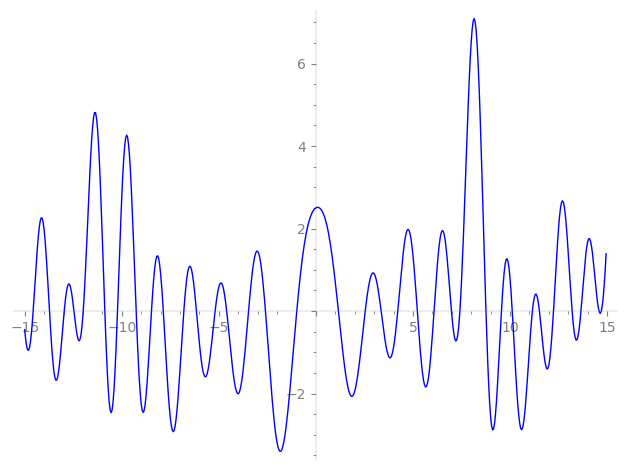| L(s) = 1 | + (0.866 + 0.5i)2-s + (0.499 + 0.866i)4-s − 1.34i·5-s + (−0.866 + 0.5i)7-s + 0.999i·8-s + (0.674 − 1.16i)10-s + (1.11 + 0.646i)11-s + (−0.343 − 3.58i)13-s − 0.999·14-s + (−0.5 + 0.866i)16-s + (1.76 + 3.05i)17-s + (1.98 − 1.14i)19-s + (1.16 − 0.674i)20-s + (0.646 + 1.11i)22-s + (3.08 − 5.33i)23-s + ⋯ |
| L(s) = 1 | + (0.612 + 0.353i)2-s + (0.249 + 0.433i)4-s − 0.603i·5-s + (−0.327 + 0.188i)7-s + 0.353i·8-s + (0.213 − 0.369i)10-s + (0.337 + 0.194i)11-s + (−0.0951 − 0.995i)13-s − 0.267·14-s + (−0.125 + 0.216i)16-s + (0.428 + 0.741i)17-s + (0.456 − 0.263i)19-s + (0.261 − 0.150i)20-s + (0.137 + 0.238i)22-s + (0.642 − 1.11i)23-s + ⋯ |
\[\begin{aligned}\Lambda(s)=\mathstrut & 1638 ^{s/2} \, \Gamma_{\C}(s) \, L(s)\cr =\mathstrut & (0.994 - 0.107i)\, \overline{\Lambda}(2-s) \end{aligned}\]
\[\begin{aligned}\Lambda(s)=\mathstrut & 1638 ^{s/2} \, \Gamma_{\C}(s+1/2) \, L(s)\cr =\mathstrut & (0.994 - 0.107i)\, \overline{\Lambda}(1-s) \end{aligned}\]
Particular Values
| \(L(1)\) |
\(\approx\) |
\(2.503715687\) |
| \(L(\frac12)\) |
\(\approx\) |
\(2.503715687\) |
| \(L(\frac{3}{2})\) |
|
not available |
| \(L(1)\) |
|
not available |
\(L(s) = \displaystyle \prod_{p} F_p(p^{-s})^{-1} \)
| $p$ | $F_p(T)$ |
|---|
| bad | 2 | \( 1 + (-0.866 - 0.5i)T \) |
| 3 | \( 1 \) |
| 7 | \( 1 + (0.866 - 0.5i)T \) |
| 13 | \( 1 + (0.343 + 3.58i)T \) |
| good | 5 | \( 1 + 1.34iT - 5T^{2} \) |
| 11 | \( 1 + (-1.11 - 0.646i)T + (5.5 + 9.52i)T^{2} \) |
| 17 | \( 1 + (-1.76 - 3.05i)T + (-8.5 + 14.7i)T^{2} \) |
| 19 | \( 1 + (-1.98 + 1.14i)T + (9.5 - 16.4i)T^{2} \) |
| 23 | \( 1 + (-3.08 + 5.33i)T + (-11.5 - 19.9i)T^{2} \) |
| 29 | \( 1 + (-4.11 + 7.12i)T + (-14.5 - 25.1i)T^{2} \) |
| 31 | \( 1 - 9.90iT - 31T^{2} \) |
| 37 | \( 1 + (-3.71 - 2.14i)T + (18.5 + 32.0i)T^{2} \) |
| 41 | \( 1 + (-6.84 - 3.95i)T + (20.5 + 35.5i)T^{2} \) |
| 43 | \( 1 + (6.26 + 10.8i)T + (-21.5 + 37.2i)T^{2} \) |
| 47 | \( 1 - 10.7iT - 47T^{2} \) |
| 53 | \( 1 - 3.30T + 53T^{2} \) |
| 59 | \( 1 + (-9.40 + 5.42i)T + (29.5 - 51.0i)T^{2} \) |
| 61 | \( 1 + (2.64 + 4.57i)T + (-30.5 + 52.8i)T^{2} \) |
| 67 | \( 1 + (7.85 + 4.53i)T + (33.5 + 58.0i)T^{2} \) |
| 71 | \( 1 + (-6.89 + 3.97i)T + (35.5 - 61.4i)T^{2} \) |
| 73 | \( 1 + 3.28iT - 73T^{2} \) |
| 79 | \( 1 + 3.32T + 79T^{2} \) |
| 83 | \( 1 + 0.731iT - 83T^{2} \) |
| 89 | \( 1 + (-11.5 - 6.65i)T + (44.5 + 77.0i)T^{2} \) |
| 97 | \( 1 + (10.5 - 6.10i)T + (48.5 - 84.0i)T^{2} \) |
| show more | |
| show less | |
\(L(s) = \displaystyle\prod_p \ \prod_{j=1}^{2} (1 - \alpha_{j,p}\, p^{-s})^{-1}\)
Imaginary part of the first few zeros on the critical line
−9.259157566064636193817743088682, −8.469373590063317255661270696373, −7.85976490971655123353011995637, −6.80212354696692036433406362722, −6.15224879417571916000835882780, −5.19120814141284909135289127145, −4.59528498747158727413187747030, −3.46919466453715707313448418349, −2.59786690171754385929248088052, −0.985118489785762891483811733156,
1.15929938600890731764833332438, 2.54071656864411538026030260544, 3.36121877616113845859014060555, 4.21641994441871277310287045075, 5.22485058949888922199392118151, 6.08534584405598494616900182394, 6.98240609474884465740650483306, 7.41639673763314657771727243027, 8.758973494537578924078141594808, 9.557942036090105109471542971354

